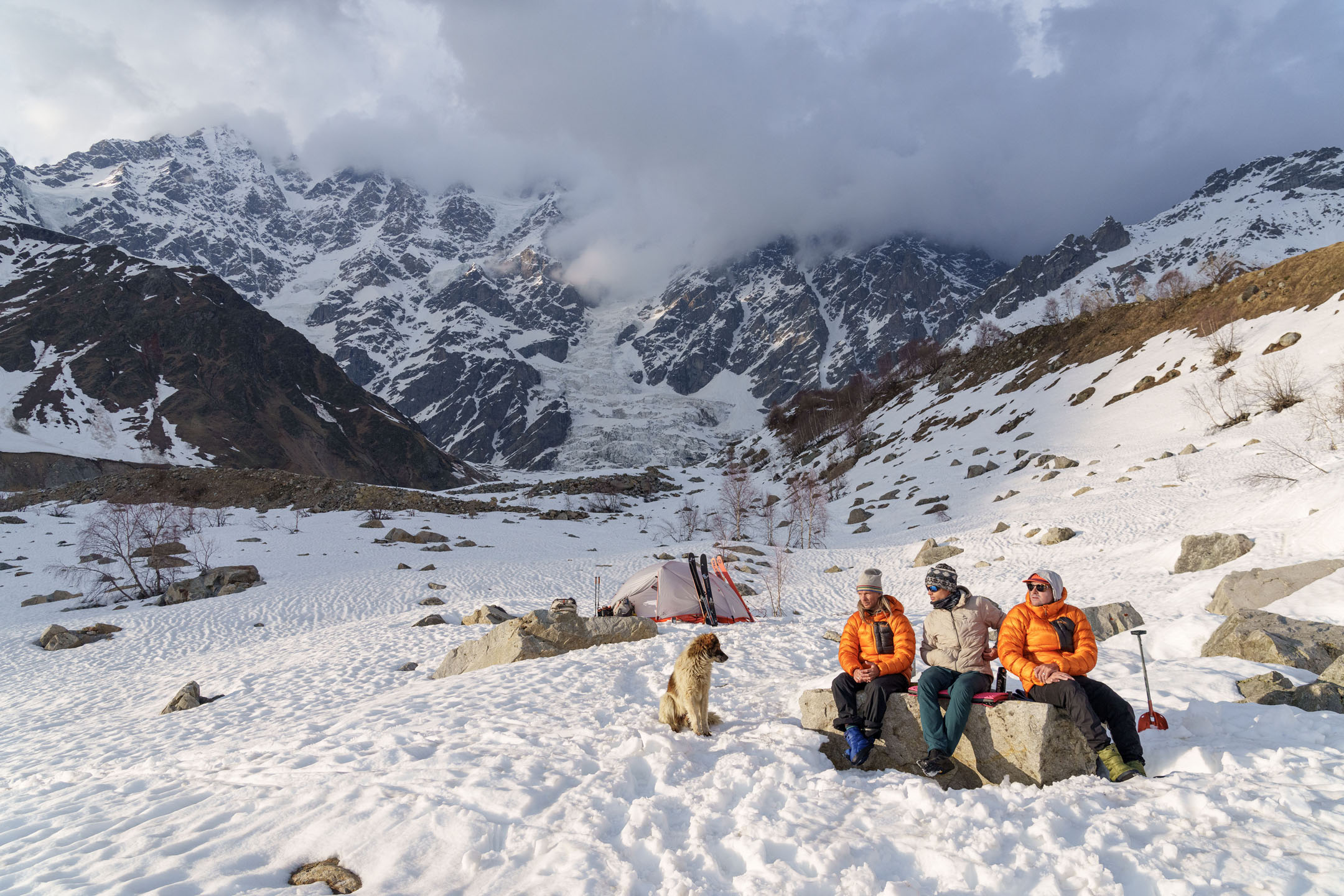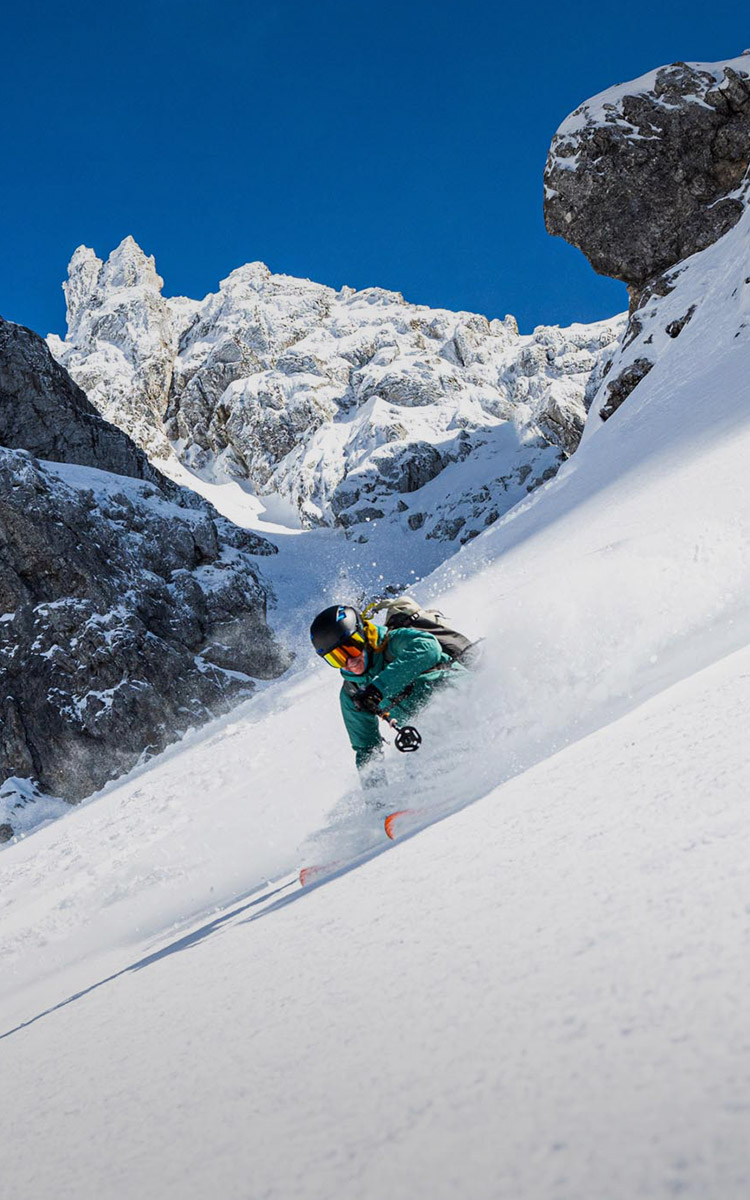Shkhara
Shkhara



“Shkhara is an absolute freaking beast of a mountain!” says action sports photographer and ski mountaineer, Fred Marmsater. In fact, it’s the highest peak in Georgia and third highest mountain in the whole of Europe. It straddles the border between Russia and the Svaneti region of Georgia in the Caucasus Mountains, and is the main summit on the Bezengi wall, an imposing massif of 14 peaks that rarely dips below 5,000m. It’s formidable, steep, heavily glaciated, and lacks any routes of medium difficulty, presenting a fierce challenge to serious mountaineers. And while a handful of teams have skied on this mountain, a true ski descent from the summit has never been done.


“There are very few places left in the world where you can get that remote that quick, and still get seriously good bang-for-your-buck adventure skiing,” says ski mountaineer, Forrest Coots. “In three or four days from the States, you can be at the base and ready to launch. From Western Europe, it’s just a four-hour flight, a six-hour drive, and you're basically at the foot of this wild, exotic mountain. It’s got that feeling of a true expedition, there are so many unknowns.”
In the spring of 2015, Forrest joined a team to attempt skiing a striking couloir off the shoulder of Shkhara’s West Summit but their efforts were thwarted by a continuous sheet of ice filling the line from top to bottom. Undeterred, Forrest returned to Georgia in mid-winter 2018 for a touring trip, seeking snowier conditions. By April 2024, he made his third visit to Georgia, ready to take on the high-altitude lines of Shkhara once more. He was joined by photographer Fred, along with professional skier Chad Sayers, and backcountry guide and professional snowboarder Nathaniel Murphy. Their plan was to further explore the skiable lines on the Bezengi Wall, and if conditions allowed, attempt to ski from the summit of Shkhara.

“They couldn’t wrap their heads around why we wanted to go out there in spring in what they called ‘avalanche season’, when the whole mountain literally falls apart.”

“I've been wanting to go there for years,” says Fred. “I'd always heard it was like the Alps before they got developed and really busy.” The ski culture in Georgia is currently thriving, although it’s still a long way off the Alps. Aside from reliable snowfall and investment in lift infrastructure pouring in, it offers that invigorating sense of high mountain adventure that the Alps can’t compete with. There are five resorts of varying size, and while none offer a patch of the skiable terrain in the likes of the French mega resorts (the largest is Gudauri with 34.8km of piste), the access to backcountry terrain is essentially unlimited. In 2025, the Freeride World Tour will return to Tetnuldi resort in Mestia, which is quickly gaining recognition as one of the most exciting stops of the tour, and as a backcountry skier’s paradise.
On the 16th of April, the team arrived in Tbilisi and continued their journey with a full day of driving to Mestia. They stopped briefly to get their expedition kit and supplies together but bypassed the freeride delights of Tetnuldi and continued much deeper into the Georgian wilderness. After a couple of hours of driving on rough mountain roads, they arrived in the village of Ushguli, one of the highest inhabited settlements in Europe. A UNESCO World Heritage Site, Ushguli is known for its ancient buildings and medieval atmosphere, and more recently, as the launch point for expeditions to the Bezengi Wall. A far cry from the developed mountain town of Mestia, it’s mainly populated by farming families, livestock and a cohort of free-ranging dogs. These days, the locals are used to the colourfully clad men and women who come to test their mettle on nearby peaks, but just ten years ago it was a different story.
“When I was there in 2015, the family who owned our guest house basically thought we were walking off to die,” remembers Forrest. “They were so stressed as we were leaving. They couldn’t wrap their heads around why we wanted to go out there in spring in what they called ‘avalanche season’, when the whole mountain literally falls apart.”



In springtime the mountains in Georgia experience a notorious warm cycle. Avalanches can reach monumental size, capable of wiping out small villages. It’s at this time of year however that, in theory, the high-altitude lines on the surrounding mountains can come into perfect skiing condition. “Those mountains are so high they are covered in ice and in the winter it’s so cold that when it snows, the snow doesn't stick. So, later in the spring you get these warm storms where it's raining down on the valley floor and in town, but up on the mountains the snow line gets much higher. All that alpine ice gets covered in warm, sticky spring snow and that's what you need to be able to ski up there,” explains Fred.
On arrival in Ushguli the wet cycle was in full swing. The team waited it out for a couple of days hoping for a break in the storm so they could reach basecamp at the toe of the Shkhara glacier in dry weather. They filled their time listening to rain hitting the shale roofs, slow roasting, and hoping for colder temperatures. “There’s no local forecast or avalanche bulletin or anything like that so it was challenging to figure out what the conditions were really like,” says Fred. “Before we arrived, we ended up trawling through Instagram to find photos that had Shkhara in the background, then just zooming in over people’s shoulders to see what the snow looked like.”
Two long days and a short recce-tour later, they decided to make the push to basecamp during a brief break in the rain. They packed up seven days’ worth of supplies and hiked to around 2,500m to the old moraine of the glacier. With a creek nearby for water and the company of a few local sheepdogs, they set up camp close enough to keep eyes on the conditions high up on Shkhara’s south face. They spent the next few days tentatively exploring the sub peaks and ridgelines around the base of the mountain. “It's crazy, it was so warm, and it wasn't freezing at night. Most of those mountains are grass covered, so there were these huge, glide avalanches to the ground everywhere. The snowpack was a metre and a half, so the avalanches were massive,” remembers Fred.
They fell into a rhythm, rising at 3am to take advantage of cooler temperatures and chasing the sun from east to west, timing their descents just as the snow softened. Afterward, they would reunite with their most loyal companion, a collie-like dog who had taken up residence in camp, joining them on the skin track before curling up and waiting while they negotiated steeper terrain. There was one line on the mountain that really caught their attention. A lightning bolt-shaped couloir that scored the southwest face of Shkhara. Once they figured out how to reach it, they could see the middle of the couloir was completely iced out with black, shimmering ice. They would have to wait.


On day four a storm thundered through the valley. It rained at camp and put down that layer of snow they had been waiting for. Finally, it was on. “That evening everyone was all fired up. We packed up full alpine kit, the whole nine yards and it was like, yes! We’re gonna go ski what we came for,” says Forrest. “As we were climbing up to it the next morning, it actually looked good in the alpenglow.”
The team made their way up to around 4,000m, but as the sun rose higher it became clear that the long-awaited layer of snow was thinner than they thought. As the sun hit, the snow melted in front of their eyes leaving a black, icy channel rather than the snow-filled couloir that they had been hoping for. “We regrouped. The wind kind of got taken out of our sails,” says Forrest. “I didn’t want to believe it, I was really trying to justify it in my mind, like no, it’s still snowy up there, but the ice was truly back.”
Though the dream of skiing Shkhara’s high couloirs didn’t materialise, the team quickly pivoted. They spent the rest of their trip hunting down the best spring corn they could find in the shadow of one of Europe’s mightiest peaks. The days were spent embracing the freedom of the Georgian backcountry and scheming a future return to tackle the lines that eluded them. “Even though it wasn't a successful trip in terms of what we wanted to ski, we still made it a really good trip... You just have to realign your goals with what the conditions are like and be mindful that if you’re only there for a short time, the chance that everything lines up perfectly is really quite slim,” says Fred. “In hindsight, we were there too early. I think if we went back again, July would be the time for it.”


Back in Ushguli, their adventure came full circle with a warm welcome from a familiar face. “That dog was the first one to welcome us back to town! He literally came for a three-day adventure, got hungry, and went home, but obviously kept an eye out for us. He was so happy to see us, we finally gave him some food.” It was moments like these (unexpected and uniquely Georgian) that made the trip unforgettable, even without ticking off their biggest objectives.
The team spent their final two days in Georgia in Tbilisi, and on arrival discovered a country at a crossroads. Protests filled the streets after growing tensions over new pro-Russian laws had finally boiled over. “There’s a lot of anti-Russian sentiment and pro-Ukrainian graffiti around, even in the countryside,” says Forrest. It’s a nation teetering between its European aspirations and an unwelcome pull back toward Russia. In the months since their trip, there has been a brewing threat of war and a contested election, but the culture, landscapes, and spirit of the people make it a place worth exploring now, before things change too much. “I would definitely say that it’s worth going there sooner rather than later,” says Forrest. “My best advice to someone who’s considering exploring Georgia? Book the plane ticket and go.” For Fred, Forrest and the rest of the team, Shkhara may have won this round, but the adventure only fuelled the fire to return and dive deeper into the heart of one of Europe’s wildest places.
Images by @Fred Marmsater
Ähnliche Storys







